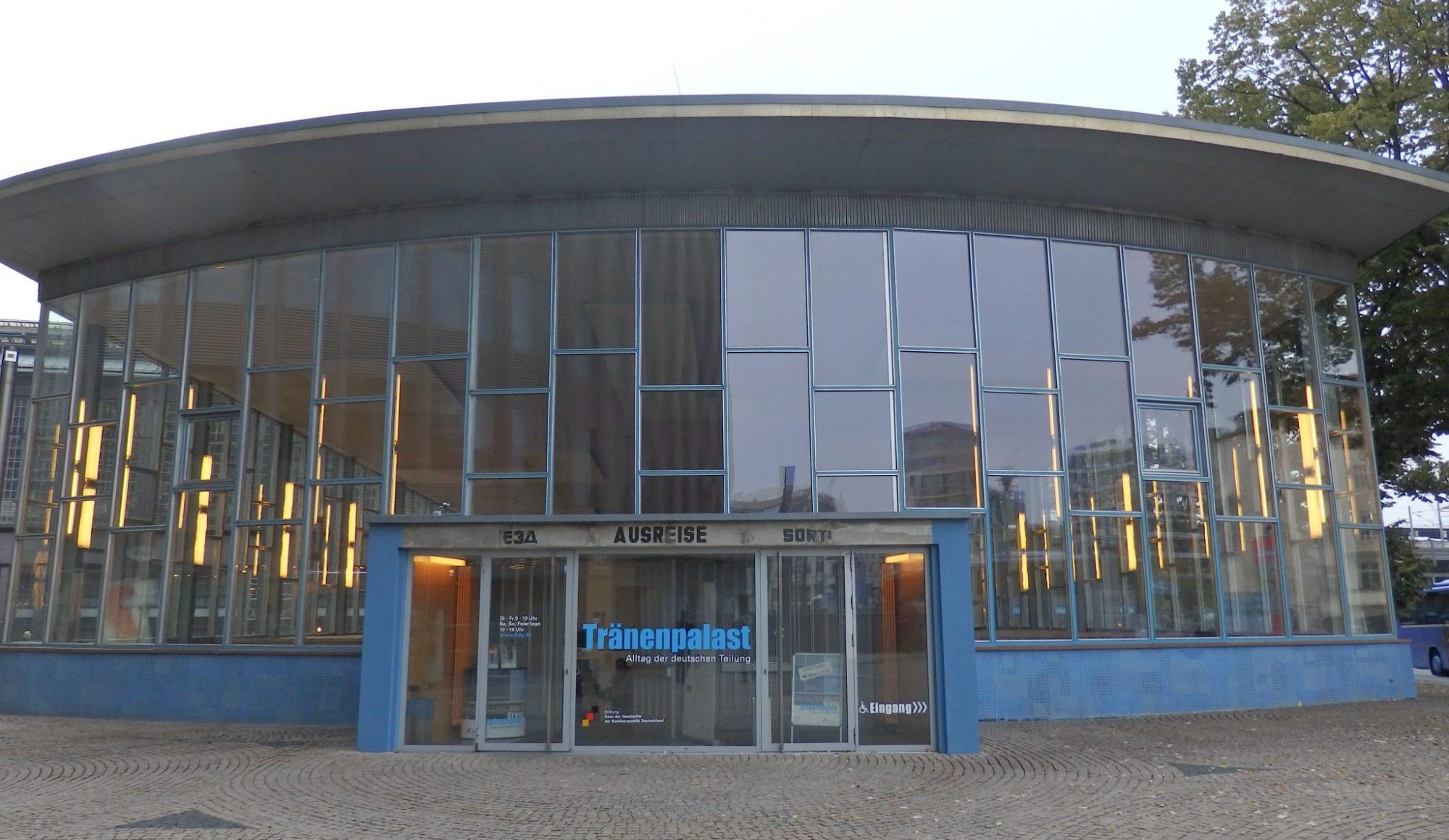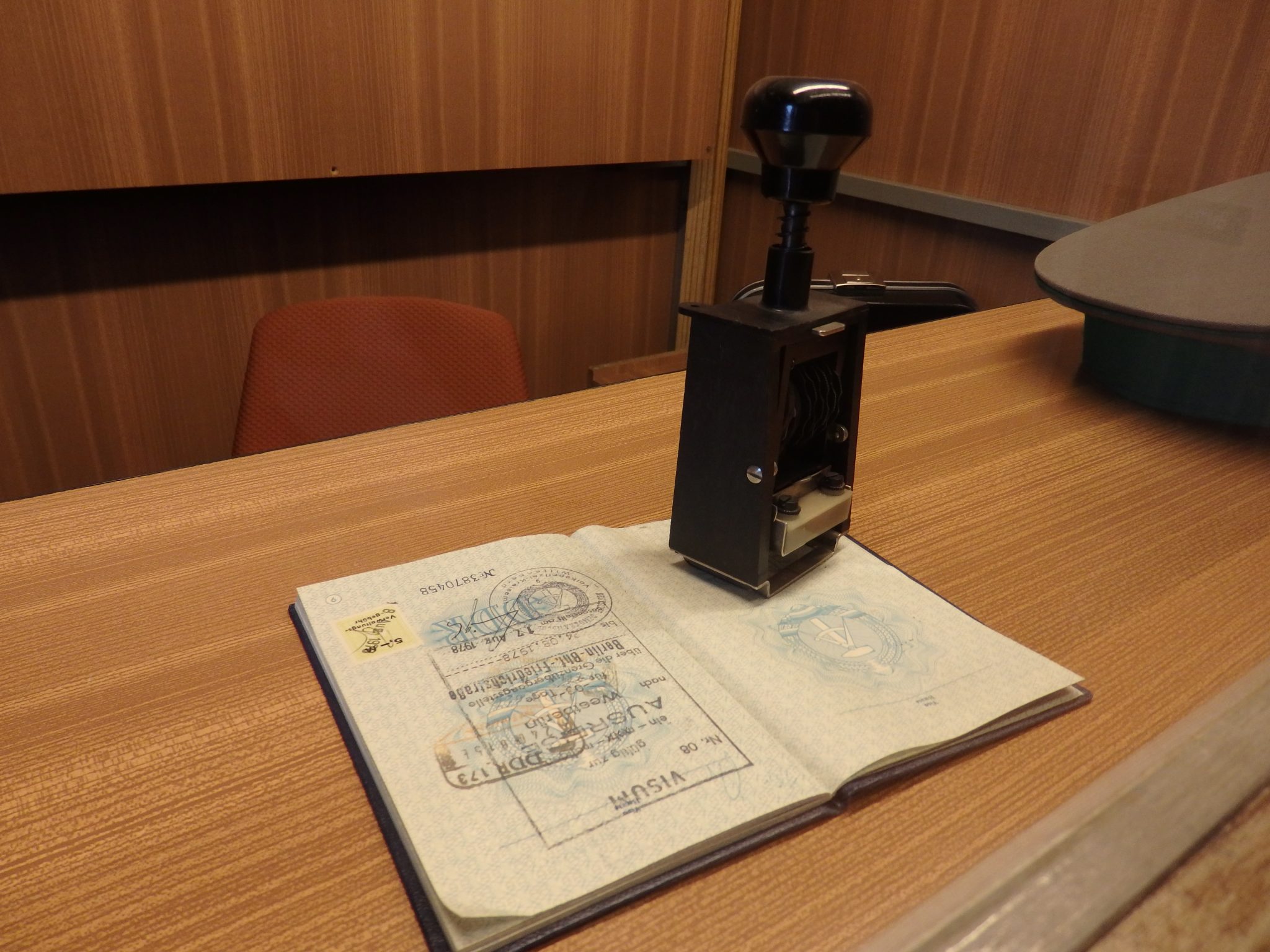Berlin’s Palace of Tears
Walking into the Palace of Tears is stepping back in time. The floor tiles, the wall clock, the “modern” design of the building: all hearken back to a 1960s aesthetic in interior design.

Standing on East German territory since 1962, the Palace of Tears was an addition to the older Friedrichstraße train station. This station stood on East German soil but still held connections to the West Berlin metro and train systems. After the Berlin Wall cut the city in two, the Palace of Tears was built to serve as a border crossing between the East and West German rail systems.
It was (and is) known as the Palace of Tears (Tränenpalast) because of the many tearful farewells that took place here. People emigrating to the West didn’t know if they’d ever be able to see their loved ones again.
You might also like to read my article about other World War II and Cold War sites in Berlin that you can visit.
The Design of the Palace of Tears
Stepping inside, I descended a short stairway to the hall’s main floor. Looking around, I saw huge glass windows, sweeping around the hall on three sides, but the floor of the hall is low, below ground level. People passing through this space could not see out to the street.
Between the windows are vintage light fixtures, and the wall clock is the original clock, in a style I remember from my 1960s childhood.

The Palace of Tears is still recognizably a train station hall, with the addition of museum elements within this large space. It includes a row of booths where immigration officials checked documents.
Museum visitors can walk through one booth as those emigrants and business travelers did during the period when Germany was divided. The booths intentionally intimidate. Standing in the narrow space, looking up at the customs official across a high counter, they must have felt like children, begging to be allowed out.
A mock-up of the Friedrichstraße station shows how the East German apparatus controlled travelers’ movement. They walked from this hall into the station itself through a carefully managed maze of hallways, designed to prevent anyone escaping East Germany without permission.
Other Exhibits in the Palace of Tears
A free audio guide explains the other exhibits in the museum. Suitcases used as display cases illustrate individuals’ stories of leaving East Germany and the few items they took with them. Similar suitcases near the exit do the same, but focus on individuals who moved back to East Germany after the fall of the Berlin Wall.
Moving through the small museum, I saw an array of Western consumer goods that the East German government sold to earn hard currency. A section on surveillance emphasizes how closely the police, along with informants, scrutinized everyone in this railway station as they came and went. And a section on protest movements explains the gradual build-up to the 1989 fall of the Berlin Wall. This part was particularly intriguing to me because from the US perspective, the Wall’s fall seemed very sudden. In fact, it was the culmination of a long effort by some very brave people.
The focus of many of the displays is individuals who passed through the Palace of Tears. It’s hard to imagine, from my privileged point of view, how people felt leaving East Germany. They knew that they were unlikely ever to go back and see the families they left behind. And yet their families might live within just a few kilometers of them. The Palace of Tears museum is a good way to get an inkling; its intact structure, passport control booths and rather sparse but well-chosen displays fill out this piece of the puzzle of divided Berlin’s history.

If you have the time, I would recommend visiting both the Palace of Tears and the DDR Museum. The two museums – one about everyday life in East Germany and one about the decision to leave East Germany – complement each other. They combine well to answer the questions “What was it like?” and “Why didn’t they just leave?”



Hi Rachel
Did not even know this existed! Moving!
It only opened in 2011. It’s smaller and less showy than the DDR museum, so I think it gets overlooked.
The multitude of windows, which seem to promise openness, are in stark contrast to the Palace of Tears real purpose of secrecy, intimidation and the power of divisiveness. The museum space itself seems to be very cold… Your posts about a city and country divided are very timely Rachel, as the threat of a new wall and great social divides are looming in the US.
It’s completely coincidence. I just happened to be in Berlin last month to lead a workshop and took some extra days to see the city. But you’re right; the idea of walls to divide people never seems to go away.
In our whirlwind tour of Berlin earlier this year we didn’t have time to see the Palace of Tears. Wish we had. We did get a pretty good feel for the divisions that existed during the divided Germany, but if we get a chance to go back we will definitely want to see this.
Yes, there are lots of options to get a look at that period in Berlin. This one is just a short stop: maybe an hour to see it well.
Rachel, you must plan a trip to Winnipeg, Canada. You would love the Canadian Museum for Human Rights.
Never been there! I’m sure I’d find it interesting.
I didn’t know that the “Tränenpalast” (a nickname so typical of Berlin’s ‘dark humor’) is now open to the public as a museum. I would have visited it last time I was in Berlin in 2013/14. I still remember the eerie feeling passing on the subway below Friedrichstraße, the semi lit disused platform with barbed wire barricades, VoPos (the east German ‘Volkspolizei’) with semi-automatic weapons patrolling, then the brightly lit short section where transit trains would stop… Yes, the regular subway from the south of West Berlin to the North of the Allied sector used to pass under Friedrichstraße on each and every journey. I disliked the trip so much that I rather took the long way around on BVG buses.
Are you talking about the ‘ghost stations’? Yes, they sound like some sort of flash of a different world that West Germans glimpsed as their trains sped by.
It was chilling to read about this museum; can’t imagine how stirring it must have been to visit.
It is!
Hi Rachel, I remember the events of ‘61 clearly from watching on tv. How Russian Tanks were drawn at checkpoints facing into West Berlin. Kennedy’s electric speech ‘’ Ich bin sin Berliner’’. The awful sight of newsreel footage showing footage of escapers being shot by their fellow countrymen. The dreadful betrayals by Stasi informants. But finally the overwhelming sense of joy when East Germans at last gained their hard won freedom. A lasting tribute to those brave souls paid the ultimate price.
Hi, Rachel.
May I recommend:
* Dresden, Halle, and Leipzig, to learn of the weeks, months, and years leading up to the “Friedliche Revolution” in 1989.
* back in Berlin, the Stasi Museum is an eye-opening view to the methods used by DDR state security on their own people.
Thank you for the recommendations! I haven’t been to Leipzig or Halle yet, but I’ve been to Dresden. I went to one museum about the Cold War in Dresden but didn’t get much out of it because it was all in German. That’s why I never wrote about it. My husband (who knows German) found it quite interesting. I have visited the Stasi Museum and wrote about here: https://rachelsruminations.com/stasi-museum-berlin/.